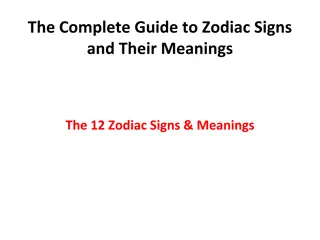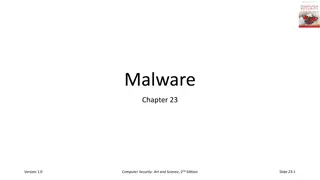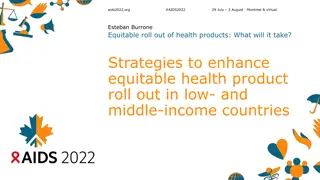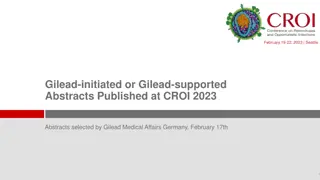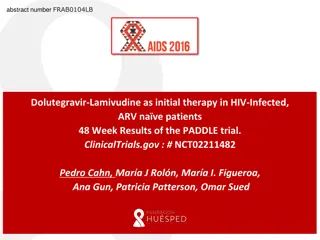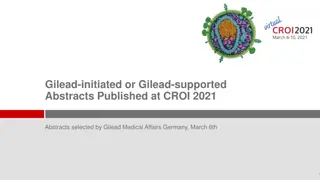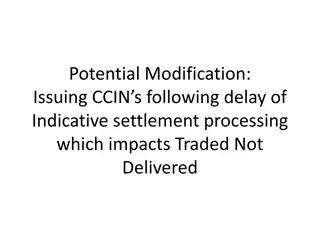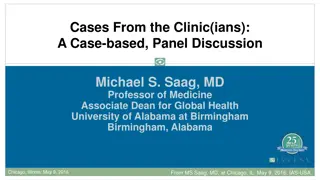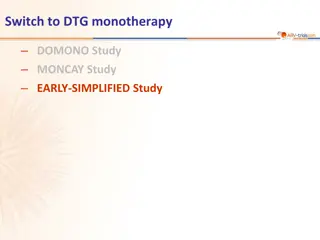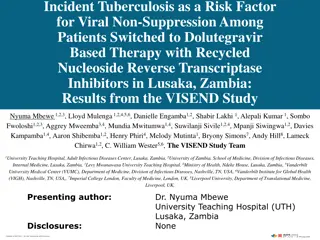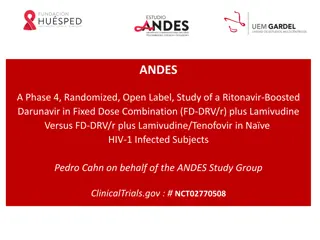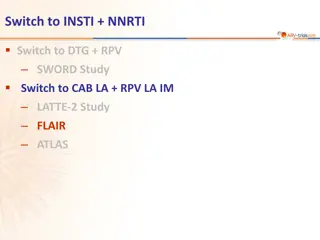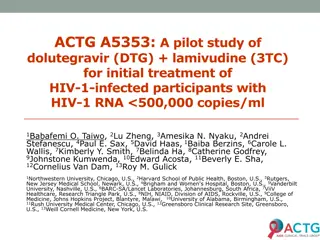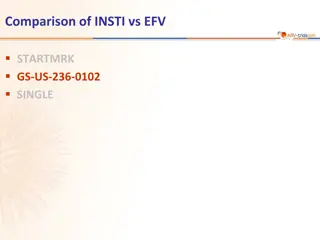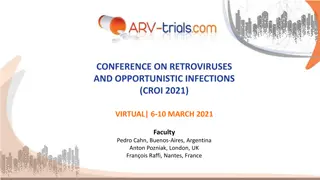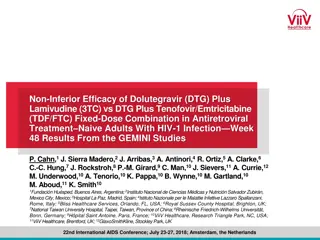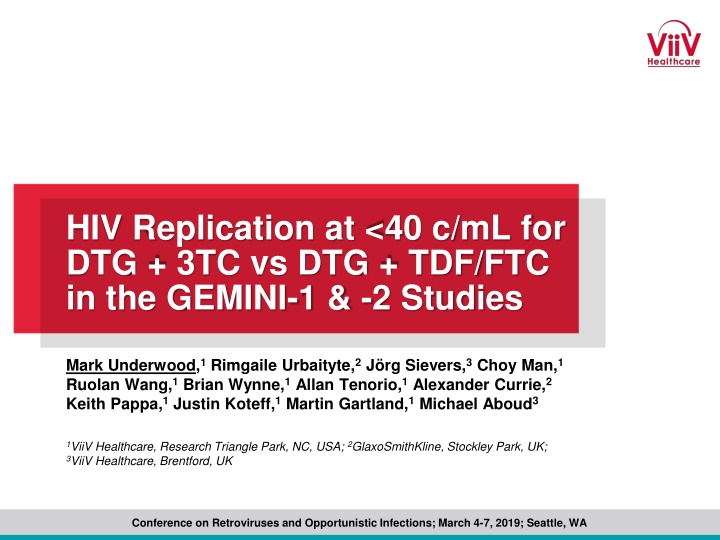
HIV Replication Patterns in Gemination Studies
Explore the findings from the GEMINI-1 and -2 studies, comparing the effectiveness of DTG + 3TC versus DTG + TDF/FTC in lowering HIV replication below 40 c/mL. The studies show promising results with both treatment arms achieving significant reductions in viral load without emergence of mutations. This analysis sheds light on the implications of stringent low-level viral load data and the management of HIV patients with different treatment regimens.
Download Presentation

Please find below an Image/Link to download the presentation.
The content on the website is provided AS IS for your information and personal use only. It may not be sold, licensed, or shared on other websites without obtaining consent from the author. If you encounter any issues during the download, it is possible that the publisher has removed the file from their server.
You are allowed to download the files provided on this website for personal or commercial use, subject to the condition that they are used lawfully. All files are the property of their respective owners.
The content on the website is provided AS IS for your information and personal use only. It may not be sold, licensed, or shared on other websites without obtaining consent from the author.
E N D
Presentation Transcript
HIV Replication at <40 c/mL for DTG + 3TC vs DTG + TDF/FTC in the GEMINI-1 & -2 Studies Mark Underwood,1Rimgaile Urbaityte,2J rg Sievers,3Choy Man,1 Ruolan Wang,1Brian Wynne,1Allan Tenorio,1Alexander Currie,2 Keith Pappa,1Justin Koteff,1Martin Gartland,1Michael Aboud3 1ViiV Healthcare, Research Triangle Park, NC, USA; 2GlaxoSmithKline, Stockley Park, UK; 3ViiV Healthcare, Brentford, UK Conference on Retroviruses and Opportunistic Infections; March 4-7, 2019; Seattle, WA
Introduction The GEMINI-1 and -2 studies in treatment-naive adults with screening HIV-1 RNA 500,000 c/mL showed dolutegravir + lamivudine (DTG + 3TC, 2DR) was non-inferior to dolutegravir + tenofovir disoproxil/emtricitabine (DTG + TDF/FTC, 3DR) at Week 48 by FDA Snapshot algorithm 91% (655/716) in the 2DR arm vs 93% (669/717) in the 3DR arm achieved HIV-1 RNA <50 c/mL Low rates of virologic withdrawal were observed at Week 48 in both the DTG + 3TC and DTG + TDF/FTC arms Respectively, 6 and 4 participants met these criteria in the DTG + 3TC and DTG + TDF/FTC arms No participants in either arm had treatment-emergent INSTI or NRTI mutations Abbott RealTime HIV-1 assay used in the studies measures viral load (VL) from 40 c/mL to 10,000,000 c/mL and provides qualitative target detected (TD) or target not detected (TND) for VL <40 c/mL Clinical and subject management implications of more stringent low-level VL data need clarification We assessed the proportion of participants with TND over time and by baseline (BL) VL for 2DR vs 3DR Cahn et al. Lancet. 2019;393:143-155. Underwood et al. CROI 2019; Seattle, WA. Poster 490. Conference on Retroviruses and Opportunistic Infections; March 4-7, 2019; Seattle, WA
Methods GEMINI-1 and GEMINI-2 Study Design Screening (28 d) Double-blind phase Open-label phase Continuation phase 1:1 DTG + 3TC DTG + 3TC (N=716) ART-naive adults VL 1000-500,000 c/mL DTG + TDF/FTC (N=717) Day 1 Week 24 Week 48 Primary endpoint Week 96 Week 144 Identically designed, randomised, double-blind, parallel-group, multicentre, non-inferiority studies Participants were randomised 1:1 to treatment with 2DR or 3DR. The proportion of participants with HIV-1 RNA <40 c/mL and TND status at Week 48 was analysed using a Cochran-Mantel-Haenszel test stratified by plasma HIV-1 RNA ( 100,000 vs >100,000 c/mL) at BL and study Proportion of participants with HIV-1 RNA <40 c/mL and TND status were summarised by visit and at Week 48 by BL HIV-1 RNA subgroup. Time to TND status overall and by BL HIV-1 RNA subgroup were estimated using non-parametric Kaplan-Meier method Underwood et al. CROI 2019; Seattle, WA. Poster 490. Conference on Retroviruses and Opportunistic Infections; March 4-7, 2019; Seattle, WA
Proportion of Participants With TND by Visit: Snapshot Analysis 90 At Week 48, similar proportions of participants had Snapshot TND in the 2DR and 3DR arms (77% [553/716] vs 73% [525/717]; adjusted difference, 3.8%; 95% CI, 0.6% to 8.2%) Proportions were also similar at Weeks 4 (34% vs 32%), 8 (52% vs 49%), 12 (60% vs 57%), 16 (59% vs 56%), 24 (65% vs 63%), and 36 (65% vs 68%) DTG + 3TC DTG + TDF/FTC 553 525 80 Proportion of participants 484 466 465 453 70 428 425 410 402 375 60 351 50 246 228 40 30 20 10 0 4 8 12 16 24 36 48 Week Underwood et al. CROI 2019; Seattle, WA. Poster 490. Conference on Retroviruses and Opportunistic Infections; March 4-7, 2019; Seattle, WA
Proportion of Participants With TND at Week 48 (Snapshot Analysis) by Baseline Plasma HIV-1 RNA Levels Baseline VL strata (c/mL) 100,000 >100,000 >250,000 >400,000 aNumber responded/Number assessed (%). bUnadjusted proportion of DTG + 3TC proportion of DTG + TDF/FTC (95% CI). DTG + 3TC n/N (%)a 463/576 (80) 90/140 (64) 25/51 (49) 5/18 (28) DTG + TDF/FTC n/N (%)a 446/564 (79) 79/153 (52) 20/46 (43) 6/24 (25) Treatment difference (95% CI)b 1.3 ( 3.4 to 6.0) 12.7 (1.4 to 23.9) 5.5 ( 14.3 to 25.4) 2.8 ( 24.2 to 29.8) Responses to TND were similar for participants with BL VL 100,000 c/mL Responses to TND were numerically higher for 2DR vs 3DR arms for participants with BL VL >100,000 c/mL. By study: GEMINI-1 response to TND: 2DR = 51/74 (69) and 3DR = 34/76 (45) GEMINI-2 response to TND: 2DR = 39/66 (59) and 3DR = 45/77 (58) Underwood et al. CROI 2019; Seattle, WA. Poster 490. Conference on Retroviruses and Opportunistic Infections; March 4-7, 2019; Seattle, WA
Kaplan-Meier Plots of Time to TND: Overall Participants Time to target not detected, wks Overall, median (95% CI) time to TND was 57 (NE, NE) days for 2DR vs 57 (57, 58) days for 3DR Participants with HIV-1 RNA <40 c/mL and missing interpretation for Target Detected (TD)/Target Not Detected (TND) status are assumed to be TD. Underwood et al. CROI 2019; Seattle, WA. Poster 490. Conference on Retroviruses and Opportunistic Infections; March 4-7, 2019; Seattle, WA
Kaplan-Meier Plots of Time to TND: By Baseline HIV-1 RNA Subgroup Time to target not detected, wks Time to target not detected, wks For the BL 100,000 c/mL stratum, median (95% CI) time to TND was 57 (56, 57) days for both 2DR and 3DR For the BL >100,000 c/mL stratum, median (95% CI) time to TND was shorter for 2DR at 113 (88, 168) days vs 169 (168, 248) days for 3DR Participants with HIV-1 RNA <40 c/mL and missing interpretation for Target Detected (TD)/Target Not Detected (TND) status are assumed to be TD. Underwood et al. CROI 2019; Seattle, WA. Poster 490. Conference on Retroviruses and Opportunistic Infections; March 4-7, 2019; Seattle, WA
Kaplan-Meier Plots of Time to TND: By Baseline HIV-1 RNA >100,000 c/mL for GEMINI-1 and GEMINI-2 GEMINI-1 median (95% CI) time to TND: 2DR = 93 (85, 168) days; 3DR = 169 (115, 252) days GEMINI-2 median (95% CI) time to TND: 2DR = 118 (113, 169) days; 3DR = 169 (133, 256) days Underwood et al. CROI 2019; Seattle, WA. Poster 490. Conference on Retroviruses and Opportunistic Infections; March 4-7, 2019; Seattle, WA
Discussion The suppression of HIV-1 RNA VL in plasma is overall recognised as predictive of antiretroviral regimen success and when elevated may predict HIV evolution and emergence of resistance More sensitive measures of HIV-1 RNA levels for patient management are exploratory. Additional analyses of low- level qualitative or quantitative HIV-1 RNA may be useful for optimising treatment/patient management Ryscavage et al. Antimicrob Agents Chemother. 2014;58:3585-3598. Underwood et al. CROI 2019; Seattle, WA. Poster 490. Conference on Retroviruses and Opportunistic Infections; March 4-7, 2019; Seattle, WA
Conclusion Similar proportions of participants in the DTG + 3TC and DTG + TDF/FTC arms had TND by Snapshot at all weeks Snapshot response rates based on TND status at Week 48 were similar between arms for the BL 100,000 c/mL subgroup and numerically higher for DTG + 3TC in the BL >100,000 c/mL subgroup Median time to TND was similar overall and in the BL VL 100,000 c/mL subgroup and less for DTG + 3TC vs DTG + TDF/FTC if >100,000 c/mL at BL These data, utilising a more stringent but exploratory TND Snapshot criterion, continue to demonstrate the effectiveness and potency of DTG + 3TC in treatment-naive participants Underwood et al. CROI 2019; Seattle, WA. Poster 490. Conference on Retroviruses and Opportunistic Infections; March 4-7, 2019; Seattle, WA

![[PDF⚡READ❤ONLINE] Gemini 4: An Astronaut Steps into the Void (Springer Praxis B](/thumb/21620/pdf-read-online-gemini-4-an-astronaut-steps-into-the-void-springer-praxis-b.jpg)
![❤[PDF]⚡ Gemini 5: Eight Days in Space or Bust (Springer Praxis Books)](/thumb/21621/pdf-gemini-5-eight-days-in-space-or-bust-springer-praxis-books.jpg)

